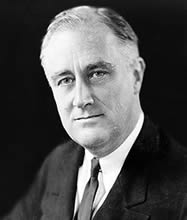Main Content
Lesson 02: The Continuous Reinventing of the Machinery of Government
The Administrative State
The Constitution was developed at a time when developing a system of administration and providing goods and services to the public through public action was less of an issue than it became in later periods. Thus, the Constitution is largely silent on issues of administrative organization and process, other than specifying that Congress has the power to create (and by implication, remove) administrative bodies by regular legislation (no constitutional amendments required) subject to approval or veto by the president in that person's role as chief executive.

Franklin Roosevelt
The result was a small and limited federal executive branch until the rise of PA in the period between the 1880s and the presidency of Franklin D. Roosevelt (1933–1945). It wasn't until the Roosevelt presidency that the United States created what scholars such as Richard Stillman call the "administrative state." This term implies a political/administrative system characterized by large public bureaucracies providing a range of public programs, some regulating private behavior and others providing direct services, such as unemployment insurance, road construction and maintenance, and so on. The administrative state in the United States was slow in coming compared to most other modern nations. As Stillman points out, most European nations went in the opposite direction in reconciling democracy and administration: Their administrative states were established as monarchical systems that were later democratized, whereas the United States started as a virtually "stateless" system with minimal administrative capacity that gradually reconciled democracy with a large state apparatus.
When we speak of the administrative state, we mean the following:
- A great deal of society's problems are assigned to public bureaucracies, and many of society's resources flow through public bureaucracies.
- Much of the political dynamics in the system revolve around the control and direction of public policies administered by public bureaucracies.
- An elaborate system of rules, laws, and delegated powers is needed to coordinate the various elements of the state and ensure it's controlled by political elites in the three constitutional branches of government.
